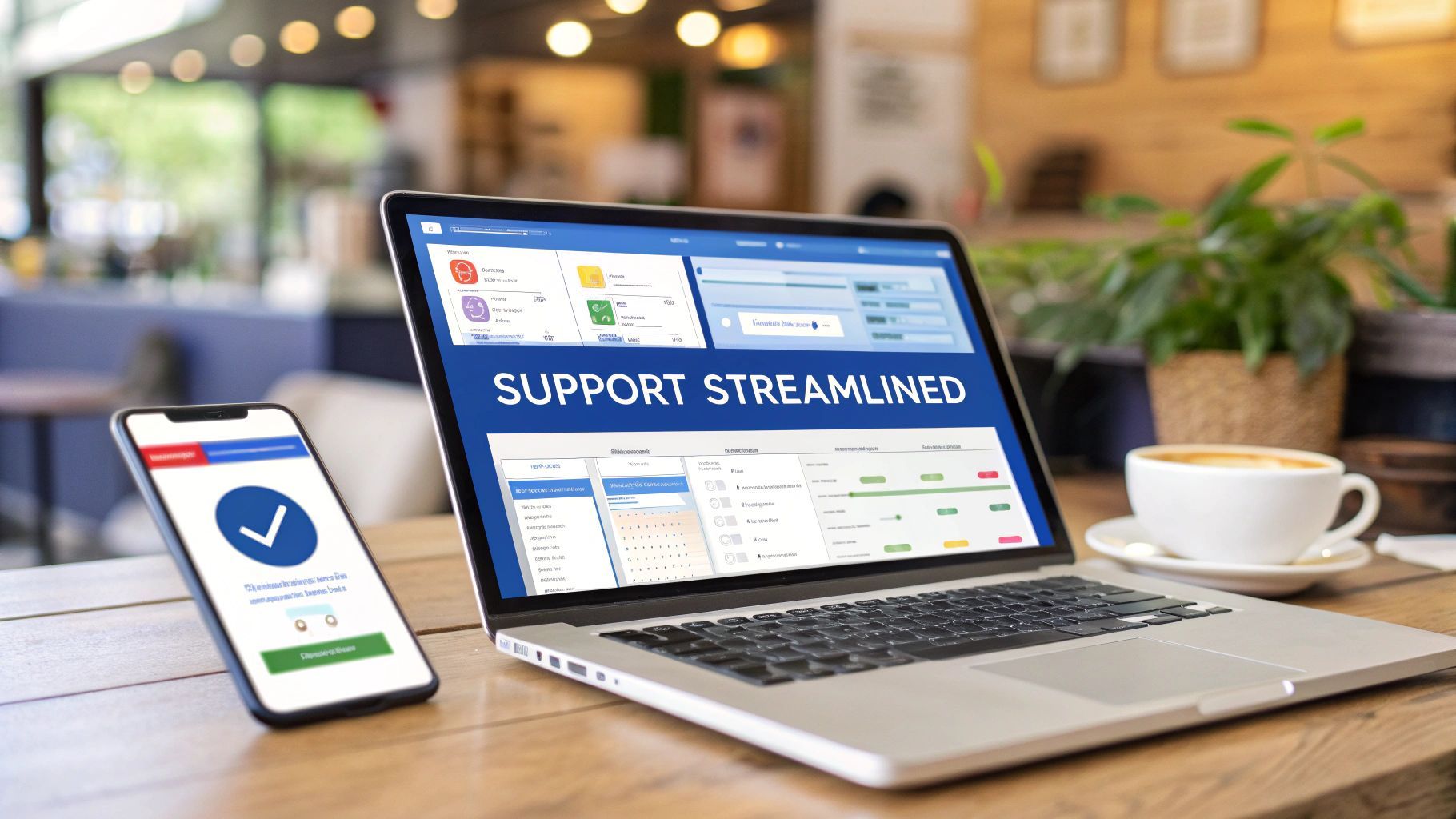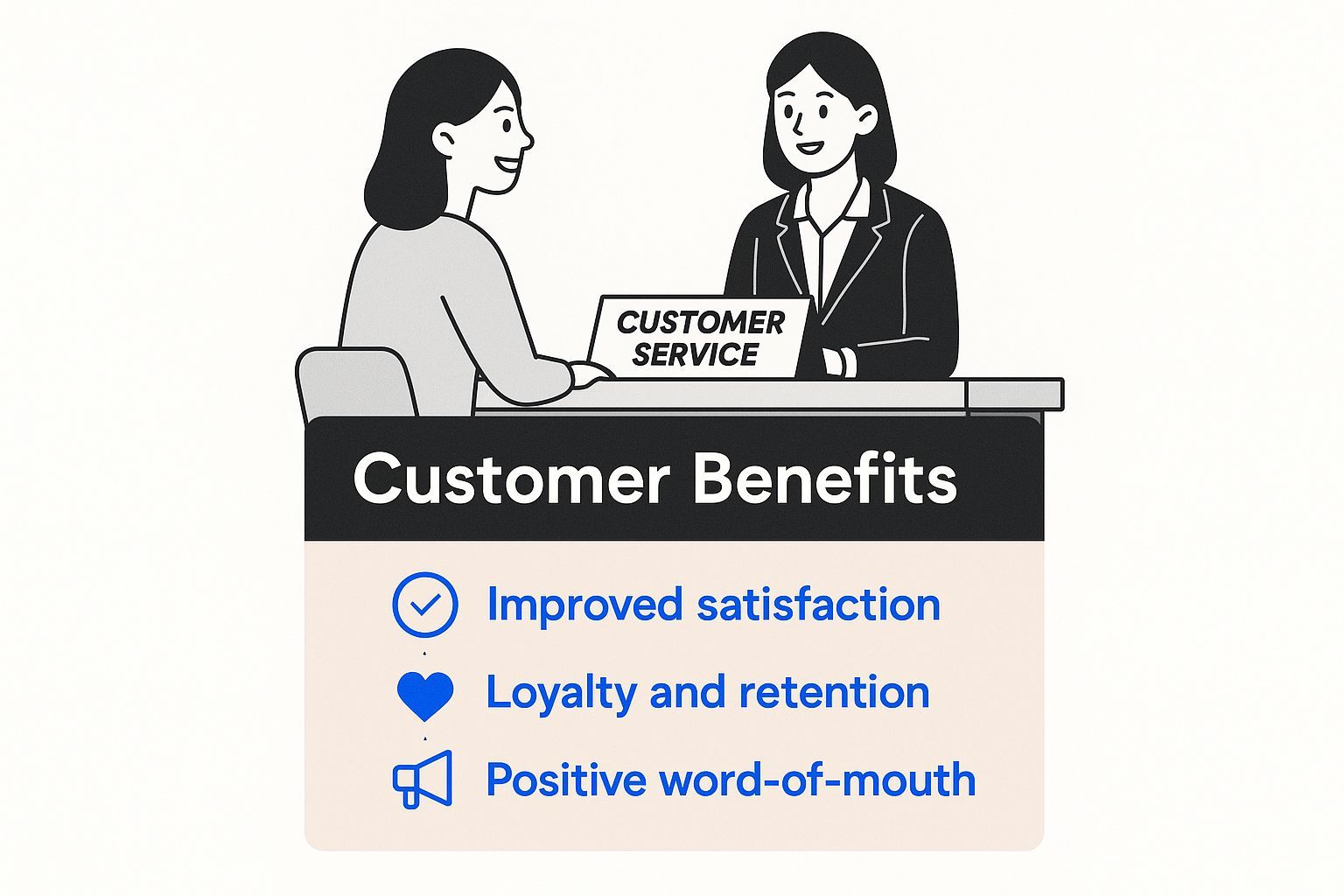
Small Business Ticketing System: Boost Support & Grow
Discuss with AI
Get instant insights and ask questions about this topic with AI assistants.
💡 Pro tip: All options include context about this blog post. Feel free to modify the prompt to ask more specific questions!
At its core, a small business ticketing system is a tool that brings all your customer conversations into one single, organized place. Forget juggling a dozen different inboxes. This system acts as a central hub for every question, comment, and problem your customers send your way.
Think of it as a digital command center for all your customer communication. It takes the messy tangle of emails, social media DMs, and website contact forms and turns each one into a neat, trackable "ticket."
Imagine trying to run a popular restaurant without an order system. Waitstaff would be shouting orders to the kitchen, cooks would be guessing who ordered what, and customers would be getting frustrated. It would be pure chaos. That's what handling customer service without a system feels like.
A small business ticketing system is like the restaurant's digital expediter. It neatly captures every single customer "order" (or inquiry), no matter where it came from, and lines it up in an organized queue. Each ticket holds the vital details: who the customer is, what they're asking for, and the entire history of their conversation.
Instead of your team frantically switching between email, Facebook, and your website's contact form, every single customer interaction is logged in one shared dashboard. This simple but powerful shift from chaos to clarity is the real magic of a ticketing system. It's a foundational tool for managing customer support interactions by organizing communication and making sure problems actually get solved.
This centralized approach pays off immediately in a few key ways:
- No More Lost Messages: Every email, chat, or form submission gets automatically captured and turned into a ticket. Nothing can slip through the cracks again.
- A Complete Customer History: Pull up a customer's record and see every conversation they've ever had with you. This context is gold for providing smart, personalized support.
- Clear Ownership and Accountability: You can assign each ticket to a specific person on your team. This ends the "I thought you were handling it" problem for good.
The primary goal of a ticketing system isn't just to answer questions; it's to create a repeatable, organized, and scalable process for delivering excellent customer service, even with limited resources.
Ultimately, a good system helps you move from constantly putting out fires to proactively managing customer relationships. It gives even a one-person shop the power to handle support with the polish and efficiency of a much larger company, setting you up to scale without letting service quality slide.

For a lot of small businesses just starting out, a shared email inbox seems like the perfect way to handle customer questions. It's simple, it's free, and in the beginning, it actually works. But as your business grows, that once-tidy inbox quickly becomes a chaotic mess—a bottleneck that’s actively slowing you down.
Suddenly, messages slip through the cracks. Replies get delayed. You start hearing from frustrated customers. Worse, you might have two different team members answering the same question, which only creates more confusion and wastes everyone's time. This kind of manual chaos isn't just inefficient; it can do real damage to your customer relationships and your reputation.
When you're managing support by hand, every little task drains your resources. Just finding a customer's past conversation means scrolling through endless email threads. There's no real accountability, no clear way to see who's handling what, and zero data to help you spot common problems. This disorganization piles up hidden costs that are far more damaging than just a few wasted hours.
You lose the ability to offer a consistent, quality experience, which is the bedrock of customer loyalty. Instead of getting ahead of issues, your team is stuck putting out one fire after another. This is where a small business ticketing system comes in. It's not just a minor upgrade; it's a completely different way of thinking about customer support. It's no surprise the global help desk ticketing software market is valued at around $5 billion in 2024—businesses everywhere are realizing these tools are essential for running a smooth operation.
A ticketing system brings every customer conversation into one central place, creating a single source of truth. It puts an end to duplicate work, gives you a searchable history for every issue, and makes it crystal clear who on your team is responsible for what.
Moving to a dedicated system shifts your business from a state of constant reaction to one of proactive management. It’s no longer about frantically fixing problems as they pop up. It's about putting a strategic asset in place that can actually help you grow.
This transition unlocks some game-changing benefits:
- Radically Faster Response Times: Tickets can be automatically sent to the right person, cutting out the manual sorting and getting customers the help they need, faster.
- Enhanced Customer Satisfaction: With a complete history of every interaction at your fingertips, your support becomes more personal and informed. Customers feel understood and valued.
- Actionable Insights: Reporting features can show you patterns in customer issues, giving you the data you need to improve your products, services, or even just your website's FAQ page.
By organizing your support, you free up your team to focus on what really moves the needle: building lasting customer relationships and growing your business. To learn more about how to boost your efficiency, check out our guide on automating customer service.
When you're shopping for a ticketing system, it's easy to get distracted by flashy features designed for massive corporations. The truth is, most of those bells and whistles will just get in the way for a small business. The real goal is to find a system with the core functions that solve your biggest headaches, not create new ones.
Think of it like this: your customer support is Grand Central Station. Inquiries are coming in from all directions—emails, social media DMs, live chat, maybe even phone calls. You need a system that can manage all that traffic without causing a pile-up.
The absolute foundation of any good system is multi-channel support. This feature pulls all your customer conversations, no matter where they start, into one single, organized queue. No more jumping between five different apps to see if a customer on Facebook is the same one who just emailed you. Everything lives in one place, giving your team the full story for every interaction.
Integrations are also a game-changer for staying on top of things. For instance, connecting your system with tools like SMS automation software can be incredibly powerful. It allows you to send automated updates directly to a customer's phone, keeping them in the loop without any manual effort from your team.

When these features work together, your customers get faster, more consistent help. They feel heard, which is exactly what builds loyalty.
A great ticketing system does more than just organize your inbox—it actively lightens your team's workload. This is where automation and self-service tools really shine.
- Simple Automation Rules: Imagine setting up a rule that automatically sends any ticket with the word "refund" straight to the person who handles billing. That's the power of automation. It routes inquiries to the right expert instantly, cutting out the middleman.
- Knowledge Base: This is your self-service portal. You can build a library of FAQs, troubleshooting guides, and tutorials. It's a win-win: customers get instant answers to common questions, and your team is freed up to tackle the trickier issues. In fact, 60% of consumers say they prefer using self-service options for simple inquiries.
A good system doesn't just help you answer questions faster; it empowers customers to find their own answers, which means fewer tickets coming in to begin with.
Finally, you can't improve what you don't measure. That's why simple reporting dashboards are a must. They give you a quick, clear look at important numbers like average response times, ticket volume, and customer satisfaction. You need actionable data, not a mountain of confusing charts. These insights are what help you spot trends and make smart decisions to elevate your service.
To make it even clearer, let's break down these essential features and why they matter for a small business.
Feature What It Does Key Benefit Multi-Channel Support Unifies communications from email, social media, and chat into one inbox. Stops messages from getting lost and gives your team full context on every customer. Shared Team Inbox Lets multiple team members view, assign, and collaborate on tickets. Prevents duplicate replies and ensures the right person handles each query. Simple Automation Automatically routes tickets, sends canned responses, or assigns tasks. Saves time on repetitive tasks and speeds up initial response times. Knowledge Base Creates a self-service library of articles and FAQs for customers. Reduces ticket volume by empowering customers to find their own answers. Internal Notes Allows private comments on tickets for team collaboration. Keeps internal chatter separate from customer replies for clear communication. Basic Reporting Tracks key metrics like ticket volume, response time, and satisfaction. Provides clear, actionable data to improve your support process. Third-Party Integrations Connects with other tools you use, like e-commerce or CRM platforms. Creates a seamless workflow and centralizes customer information.
Focusing on these core elements ensures you get a tool that genuinely supports your team and helps your business grow, without the overwhelming complexity of an enterprise-level platform.
When you start looking for a small business ticketing system, one of the first big forks in the road is deciding between an on-premise setup or a cloud-based one. For most small businesses, this isn't really a long debate. The cloud is almost always the way to go, thanks to its simplicity, lower cost, and incredible flexibility.
Think about an on-premise system for a second. It means you're buying your own expensive servers and finding a place to put them. Then, you're on the hook for every single software update, security patch, and even hiring the IT folks to keep it all running. It's a costly, complicated path that distracts you from what you should be doing: running your business.
A modern cloud-based ticketing system gets rid of all that heavy lifting. Instead of managing the software yourself, you’re essentially subscribing to a service. The provider handles all the backend headaches for you. This approach comes with some huge wins, especially for a growing company.
- Lower Upfront Costs: Forget about dropping a ton of cash on server hardware. You just pay a predictable monthly or annual subscription fee.
- Effortless Scalability: As your business and team expand, a cloud solution scales right alongside you. Need to add a few more agents? It's usually just a few clicks to upgrade your plan—no technical mess involved.
- Automatic Updates and Maintenance: The provider takes care of all the updates, security, and maintenance behind the scenes. Your system stays up-to-date and secure without you ever having to lift a finger.
This move to the cloud isn't just a fad; it's a major shift in how businesses operate. Cloud-based help desk ticketing systems now dominate the market precisely because they're so accessible and cost-effective for small and medium-sized companies. You can read more about this market trend at Data Insights Market.
Okay, so you're sold on the cloud. The next step is picking the right provider. This is where you need to look past the flashy features list, because not all platforms are built the same.
A great provider acts as a true partner in your success. They should offer more than just software—they should provide robust security, reliable performance, and seamless integrations that make your entire operation run smoother.
You need to find a provider that guarantees strong data security protocols and meets compliance standards like GDPR to keep your customer data safe. Also, check their uptime promises. The last thing you want is your support system crashing right in the middle of a busy day. Finally, think about how well the platform plays with the other tools you already use, like your CRM or e-commerce software.
To help you sort through your options, digging into a detailed guide on comparing help desk software solutions can be incredibly helpful. A flexible solution that connects with your existing tech stack will support your growth, not slow it down.

Getting your hands on a powerful small business ticketing system is a great start, but the real magic happens during the rollout. A successful implementation isn't about flipping a switch and hoping everyone figures it out. It's about carefully introducing the tool in a way that truly helps your team and shows its value right away.
The key is to start simple. It’s tempting to jump in and turn on every single bell and whistle, but that’s a recipe for confusion. Instead, focus on building a solid, straightforward foundation first. Think progress, not perfection.
Begin by plugging in the communication channels your customers are already using to contact you. For most small businesses, this means starting with your main support email and your most active social media pages, like Facebook or Instagram.
Modern systems make this part surprisingly easy. They usually walk you through forwarding your emails or authorizing your social accounts in just a few clicks. This one change instantly brings all your customer conversations into a single, organized place. No more frantic toggling between inboxes and DMs.
Next, dip your toes into automation. You don't need to build elaborate, multi-stage workflows right away. Start with small, high-impact automations that give your team an immediate win. For a closer look at what's possible, you can learn how to automate customer support to take repetitive tasks off your team's plate.
A successful launch prioritizes clarity and immediate wins. By starting with essential channels and simple automations, you build team confidence and demonstrate the system's value from the very first ticket.
With your channels connected, the next critical step is getting your team comfortable and confident. This involves setting up a few basic elements that will make their day-to-day work noticeably easier and more consistent.
Start by creating a few canned responses for your top 3-5 frequently asked questions. Think about things like "What's your return policy?" or "Where is my order?" This simple setup saves your team from typing out the same reply over and over, all while making sure every customer gets a fast, on-brand answer.
This kind of clear, visual organization gives your team an at-a-glance overview of their workload, helping them prioritize effectively.
Finally, establish your ticket statuses. You don't need anything complicated. Simple labels like New, In Progress, Awaiting Customer, and Resolved bring instant order to the chaos. These statuses make it crystal clear who needs to act next on any given ticket, preventing guesswork and ensuring no customer request falls through the cracks. This initial structure is the framework you'll build upon as your team and business grow.
Let’s be honest: even the most amazing new tool can hit a few bumps during rollout. Bringing a small business ticketing system into your company isn't just a technical swap—it’s a fundamental change to how your team works every single day. If you know what to expect, you can pave the way for a much smoother transition.
You'll likely run into two main hurdles: pushback from your team and concerns about the cost. Your employees, who are probably used to managing everything from a shared inbox, might see this new system as just another thing to learn. At the same time, leadership might balk at adding another subscription to the budget. The trick is to shift the conversation from process and price to pure, undeniable value.
Getting your team to embrace the new system is everything. The most effective way to do this? Show them, don't just tell them, how it will make their lives easier by cutting out the tedious, manual work they hate.
Frame it as a solution to their biggest headaches. Point out how it completely gets rid of the "who's on it?" guesswork and puts a stop to those awkward duplicate replies.
Focus on the clear, immediate wins for them:
- No more lost messages. Every single customer email or message gets logged and tracked. Nothing falls through the cracks.
- Crystal-clear ownership. Tickets get assigned, so there’s never any confusion about who’s responsible for what.
- Less grunt work. Canned responses and simple automations can handle the same questions that pop up a dozen times a day.
The moment your team sees the system as a tool that helps them do a better job, rather than one that just watches over their shoulder, you'll see adoption rates climb. For more ideas on empowering your support staff, take a look at these essential help desk best practices.
The global market for IT ticketing systems hit an estimated $5.3 billion in 2024, but that number doesn't always resonate with a small business owner staring at a new expense. For instance, about 30% of SMEs in Europe said cost and integration problems were major roadblocks for them. You can read more on these market findings from Verified Market Reports.
Instead of talking about the subscription as a "cost," you need to frame it as what it really is: an investment in your company's health.
Think about it this way. This tool is your front line for protecting your brand's reputation. It's a machine for boosting your team's efficiency. And it's one of the most direct ways to improve customer retention.
When you calculate the hours saved from eliminating manual follow-up and the lifetime value of keeping just one frustrated customer from walking away, the system practically pays for itself. It’s not an expense; it’s a down payment on smart, sustainable growth.
It's one thing to understand the benefits of a ticketing system on paper, but it's another to commit to a new tool for your business. It's totally normal to have some lingering questions. Let's tackle some of the most common ones we hear from small business owners just like you.
Absolutely. In fact, you could argue it's even more critical for a solopreneur. When you're the one doing everything—sales, marketing, and support—staying organized isn't just a nice-to-have; it's what keeps the lights on.
Think of a small business ticketing system as your own personal support assistant. It's the safety net that ensures no customer message ever falls through the cracks. It helps you project a polished, professional image and lets you build solid, scalable processes right from the start, so you're ready for growth when it comes.
That’s the million-dollar question, isn't it? The good news is that the cost is far more flexible than most people assume. Pricing is all over the map, and many companies offer free plans that are perfect for a solo operator or a very small team just getting started.
As you need more features, paid plans typically start in the neighborhood of $10 to $30 per user, per month.
The real trick is to avoid the temptation of a feature-packed enterprise plan you'll never actually use. Zero in on a provider that delivers the core functions you need—like a shared inbox and some basic automation—to solve your immediate problems without breaking the bank.
I get it—the thought of moving everything over can feel daunting. But while any new tool has a bit of a learning curve, modern ticketing systems are built with ease of use in mind. The transition is usually much smoother than business owners anticipate.
Most platforms have simple setup wizards that practically hold your hand through the process of connecting your email accounts. Once connected, your emails start showing up as organized tickets automatically. The best way to make the switch is to start small. Just focus on mastering the basics first. This way, it feels less like a monumental shift and more like a simple, powerful upgrade that your team will appreciate right away.
Ready to see how an AI-powered, multi-channel ticketing system can bring calm to your customer support chaos? Spur centralizes your communications and automates routine tasks so you can focus on growth. Start your free 7-day trial today.
